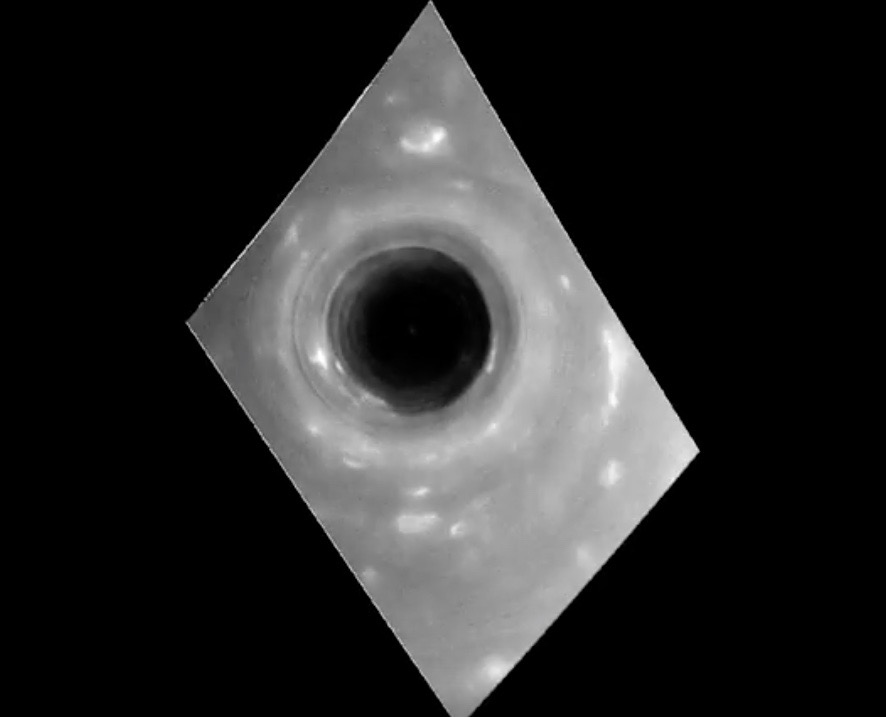Wow! Cassini's Bird's-Eye View of Saturn Plunge Astonishes in New Video

An amazing new video shows just what NASA's Cassini spacecraft saw during its first "Grand Finale" plunge between Saturn's cloud tops and the gas giant's rings last week.
The new Saturn dive video captures about an hour of Cassini observations on April 26, starting near the planet's north polar vortex, and the bizarre hexagonal jet stream that surrounds it, and heading south from there.
"I was surprised to see so many sharp edges along the hexagon's outer boundary and the eye-wall of the polar vortex," Cassini imaging team associate Kunio Sayanagi, who's based at Hampton University in Virginia, said in a statement. [Cassini's Ring-Diving Risks & Rewards at Saturn (Video)]
"Something must be keeping different latitudes from mixing to maintain those edges," added Sayanagi, who helped produce the new video.
The view shifts over the course of the dive video in several different ways. For example, Cassini gets closer to Saturn's cloud tops, dropping in altitude from 45,000 miles to 4,200 miles (72,400 to 6,700 kilometers). As a result, image resolution changes from 5.4 miles (8.7 km) per pixel to 0.5 mile (0.8 km) per pixel, NASA officials said.
In addition, near the end of the movie, "the camera frame rotates as the spacecraft reorients to point its large, saucer-shaped antenna in the direction of the spacecraft’s motion," NASA officials wrote in the same statement. "The antenna was used as a protective shield during the crossing of Saturn's ring plane."
That shield didn't end up taking very many hits; Cassini's first dive revealed that the narrow gap between Saturn and its innermost rings is surprisingly empty.
Get the Space.com Newsletter
Breaking space news, the latest updates on rocket launches, skywatching events and more!
The $3.2 billion Cassini-Huygens mission — a joint effort of NASA, the European Space Agency and the Italian Space Agency — launched in October 1997 and reached the Saturn system in July 2004. (Huygens was a lander that the Cassini mothership helped deliver to the surface of the ringed planet's largest moon, Titan, in January 2005.)
The Cassini orbiter is almost out of fuel, so mission controllers are leading the probe through its last few months of life. This Grand Finale phase consists of 22 daring dives through the Saturn rings' gap, with each one coming about 6.5 days after the last.
The first plunge occurred on April 26 and the second on Tuesday night (May 2). The third one will take place in the early morning hours of May 9 EDT.
There is still a lot more to be learned from these additional dives, mission team members said.
"The images from the first pass were great, but we were conservative with the camera settings," Cassini imaging team member Andrew Ingersoll, of the California Institute of Technology in Pasadena, said in the same statement. "We plan to make updates to our observations for a similar opportunity on June 28 that we think will result in even better views."
Cassini will end its life with an intentional dive into Saturn's atmosphere on Sept. 15. This suicide plunge is intended to ensure that the spacecraft doesn't contaminate Titan or fellow Saturn moon Enceladus —both of which may be capable of supporting life — with microbes from Earth, mission team members have said.
Follow Mike Wall on Twitter @michaeldwall and Google+. Follow us @Spacedotcom, Facebook or Google+. Originally published on Space.com.
Join our Space Forums to keep talking space on the latest missions, night sky and more! And if you have a news tip, correction or comment, let us know at: community@space.com.

Michael Wall is a Senior Space Writer with Space.com and joined the team in 2010. He primarily covers exoplanets, spaceflight and military space, but has been known to dabble in the space art beat. His book about the search for alien life, "Out There," was published on Nov. 13, 2018. Before becoming a science writer, Michael worked as a herpetologist and wildlife biologist. He has a Ph.D. in evolutionary biology from the University of Sydney, Australia, a bachelor's degree from the University of Arizona, and a graduate certificate in science writing from the University of California, Santa Cruz. To find out what his latest project is, you can follow Michael on Twitter.









